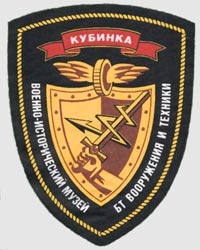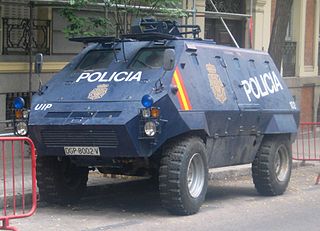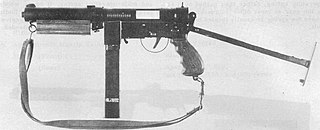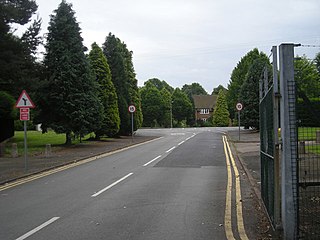Special Operations Executive (SOE) was a British organisation formed in 1940 to conduct espionage, sabotage and reconnaissance in German-occupied Europe and to aid local resistance movements during World War II.

The Renault FT was a French light tank that was among the most revolutionary and influential tank designs in history. The FT was the first production tank to have its armament within a fully rotating turret. The Renault FT's configuration became and remains the standard tank layout. Consequently, some armoured warfare historians have called the Renault FT the world's first modern tank.

The Tankgewehr M1918 (transl. Tankgun), also known as the Mauser 13mm anti-tank rifle and T-Gewehr in English, is a German anti-tank rifle—the first rifle designed for the sole purpose of destroying armored targets—and the only anti-tank rifle to see service in World War I. Approximately 16,900 were produced.

The Kubinka Tank Museum is a large military museum in Kubinka, Odintsovsky District, Moscow Oblast, Russia where tanks, armoured fighting vehicles (AFVs) and their relevant information are displayed and showcased. The museum consists of open-air and indoor permanent exhibitions of many famous tanks and armored vehicles from throughout the 20th and 21st centuries. It also houses and displays many unique, unusual and one-of-a-kind military vehicles of which there are very few remaining examples, such as the German Panzer VIII Maus super-heavy tank, Troyanov's Object 279 Kotin heavy tank, the Karl-Gerät heavy self-propelled artillery, and the Object 120 Su-152 "Taran" tank destroyer, amongst other single or limited-production prototypes from the Soviet Union and Nazi Germany.

The Musée national de la Marine is a maritime museum located in the Palais de Chaillot, Trocadéro, in the 16th arrondissement of Paris. It has annexes at Brest, Port-Louis, Rochefort, and Toulon. The permanent collection originates in a collection that dates back to Louis XV of France.

The Musée de l'Armée is a national military museum of France located at Les Invalides in the 7th arrondissement of Paris. It is served by Paris Métro stations Invalides, Varenne and La Tour-Maubourg

The Musée de l'Homme is an anthropology museum in Paris, France. It was established in 1937 by Paul Rivet for the 1937 Exposition Internationale des Arts et Techniques dans la Vie Moderne. It is the descendant of the Musée d'Ethnographie du Trocadéro, founded in 1878. The Musée de l'Homme is a research center under the authority of various ministries, and it groups several entities from the CNRS. The Musée de l'Homme is one of the seven departments of the Muséum national d'histoire naturelle. The Musée de l'Homme occupies most of the Passy wing of the Palais de Chaillot in the 16th arrondissement. The vast majority of its collection was transferred to the Quai Branly museum.

The Thyssen Henschel UR-416 is a German armoured personnel carrier, first introduced in 1969 and based on the body of the Mercedes-Benz Unimog light truck.
Georges Ladoux was an army major and from 1914 the head of the Deuxième Bureau, French military intelligence during World War I. He was responsible for recruiting Mata Hari as a French spy, whom he met in Vittel in 1916. Ladoux was later arrested for being a double agent himself, but eventually cleared of all charges.
Jean-Baptiste Tournassoud was a French photographer and military officer.

The Welgun was a prototype submachine gun developed by the British irregular warfare organisation, the Special Operations Executive. Although it performed well in tests, it was never adopted, and was produced in small numbers only.

The Royal Museum of the Armed Forces and Military History, also known as the Royal Military Museum, is a military museum that occupies the two northernmost halls of the historic complex in the Parc du Cinquantenaire/Jubelpark in Brussels, Belgium. This site is served by the metro stations Schuman and Merode on lines 1 and 5.
Station IX was a secret British Special Operations Executive factory making special weapons and equipment during World War II.

Weapons of Honour are ceremonial weapons awarded for service or assistance to France.

The Donnington Historic Weapons Collection is a collection of weapons accumulated by MoD Donnington in Shropshire, England, over a long period of time. It is now housed at the Combined Military Services Museum in Maldon, Essex, England.

Captain Peter Miles Riggal served with the Lincolnshire Regiment and was an expert in the use of explosives. He was recruited by SOE and worked as an instructor. Later in the war he was attached to Force 136 in the Far East, and instructed agents who were to be dropped into Japan to destroy key targets during the planned invasion of Japan. Their skills were not put into use as the war with Japan was ended by the use of the atom bomb.

The Secret Army was an organisation within the Belgian Resistance, active during the German occupation of Belgium during World War II. Founded in August 1940 as the Belgian Legion, the Secret Army changed its name on a number of occasions during its existence, adopting its final appellation in June 1944. With more than 54,000 members, it was by far the largest resistance group active in the country.

The Lebanese Arab Army – LAA (Arabic: جيش لبنان العربي transliteration Jayish Lubnan al-Arabi), also known variously as the Arab Army of Lebanon (AAL) and Arab Lebanese Army or Armée arabe du Liban (AAL) in French, was a predominantly Muslim splinter faction of the Lebanese Army that came to play a key role in the 1975–77 phase of the Lebanese Civil War.

MoD Donnington consists of a British Army barracks and the Defence Fulfilment Centre, and is situated to the north of Donnington, Telford, Shropshire. The barracks on the site will close in 2029.















